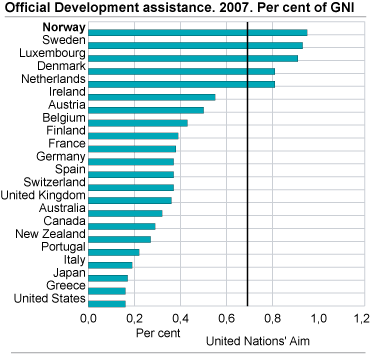Content
Published:
This is an archived release.
Decline in total development aid from OECD-countries in 2007
Figures from the OECD, show that total net official development assistance (ODA) was reduced from 0.31 per cent of their combined Gross National Income (GNI) in 2006 to 0.28 percent in 2007. However, adjusting for debt relief and taking account of both inflation and exchange rate movements, aid increased by 2 per cent from 2006.
Data from members of the Development Assistance Committee (DAC), as reported by the OECD, show that total net official development assistance (ODA) was USD 103.5 billion in 2007. ODA was extraordinary high in 2005 (USD 107.1 billion) and 2006 (USD 104.4 billion), due to large debt relief operations, in particular for Iraq and Nigeria. Debt relief approximately halved from USD 18.6 billion in 2006 to USD 8.9 billion in 2007 as these operations tapered off. Excluding debt relief grants, DAC members’ net ODA rose by 2 per cent, including adjustment for inflation and exchange rate movements.
The level of development aid is usually measured as a percentage of GNI and is often used to compare countries’ expenditure on foreign aid. In 1970, the UN resolved that development aid should account for 0.7 of GNI. Norway, Sweden and Denmark achieved this goal relatively quickly in the 1970s. In 2007, only the Scandinavian countries, the Netherlands and Luxembourg met the aim.
0.28 per cent of GNI
For the DAC countries combined, the percentage of GNI used for development aid was 0.28 per cent in 2007, compared with 0.31 per cent in 2006. Measured in US dollars, the DAC countries decreased their development aid by 0.9 billion.
United States the largest contributor
The largest donors in 2007, by volume, were the United States, followed by Germany, France, the United Kingdom and Japan. The US contributed with USD 21.8 billion, down from USD 23.5 billion in 2006. The decline was mostly due to decreased debt relief, and a reduction in ODA to Iraq. US expenditure on development aid was 0.16 per cent of GNI in 2007.
Norway contributed with 0.95 per cent of GNI
Norway’s development aid was 0.95 per cent of GNI in 2007, while the percentage in 2006 was 0.89. The expenditure on development aid increased by USD 0.7 billion to 3.7 billion in 2007. In real terms, corrected for price and exchange rate movements, this corresponds to an increase of 13.4 per cent, mostly due to increased equity investment.
| Million US dollar |
Real per cent
change1 |
Real per cent change1.
Without debt relief grants |
|||||||||||||||||||||||||||||||||||||
|---|---|---|---|---|---|---|---|---|---|---|---|---|---|---|---|---|---|---|---|---|---|---|---|---|---|---|---|---|---|---|---|---|---|---|---|---|---|---|---|
| 2006 | 2007* |
Debt relief
grants in 2007* |
|||||||||||||||||||||||||||||||||||||
| Norway | 2 954 | 3 728 | 61 | 13.4 | 12.4 | ||||||||||||||||||||||||||||||||||
| Denmark | 2 236 | 2 562 | 123 | 2.9 | 3.2 | ||||||||||||||||||||||||||||||||||
| Sweden | 3 955 | 4 339 | 74 | -2.5 | 3.5 | ||||||||||||||||||||||||||||||||||
| Canada | 3 684 | 4 080 | 15 | 1.2 | 8.5 | ||||||||||||||||||||||||||||||||||
| France | 10 601 | 9 884 | 1 485 | -16.4 | 5.1 | ||||||||||||||||||||||||||||||||||
| Italy | 3 641 | 3 971 | 570 | -2.6 | 48.5 | ||||||||||||||||||||||||||||||||||
| Japan | 11 136 | 7 679 | 1 576 | -29.8 | -23.7 | ||||||||||||||||||||||||||||||||||
| Netherlands | 5 452 | 6 224 | 392 | 3.2 | 2.6 | ||||||||||||||||||||||||||||||||||
| Germany | 10 435 | 12 291 | 2 867 | 6.1 | 10.0 | ||||||||||||||||||||||||||||||||||
| United Kingdom | 12 459 | 9 849 | 70 | -29.6 | -2.7 | ||||||||||||||||||||||||||||||||||
| United States | 23 532 | 21 787 | 40 | -9.8 | -3.4 | ||||||||||||||||||||||||||||||||||
| Others | 14 285 | 17 097 | 1 710 | - | - | ||||||||||||||||||||||||||||||||||
| Total DAC | 104 370 | 103 491 | 8 983 | -8.5 | 2.0 | ||||||||||||||||||||||||||||||||||
| 1 | Taking account of both inflation and exchange rate movements. |
Data supplied by DAC members on their 2007 aid flows are available on: www.oecd.org/dac/stats/idsonline
For more information can also be found on: www.oecd.org/development , www.norad.no and in Statistical yearbook .
Tables:
Contact
-
Statistics Norway's Information Centre
E-mail: informasjon@ssb.no
tel.: (+47) 21 09 46 42

